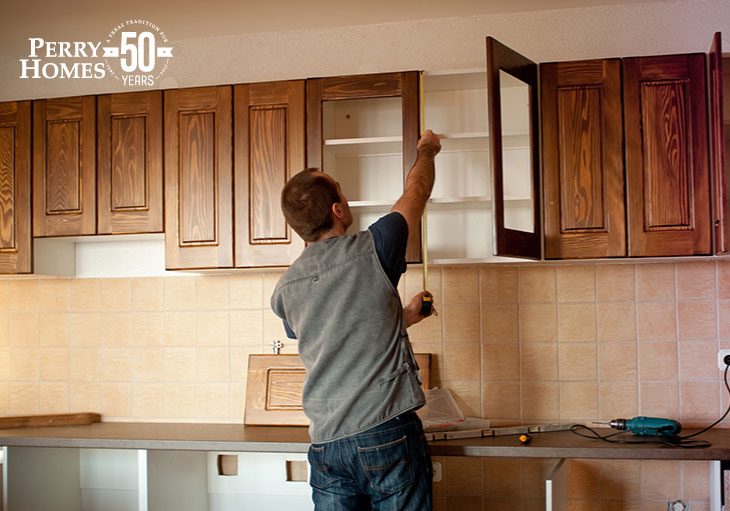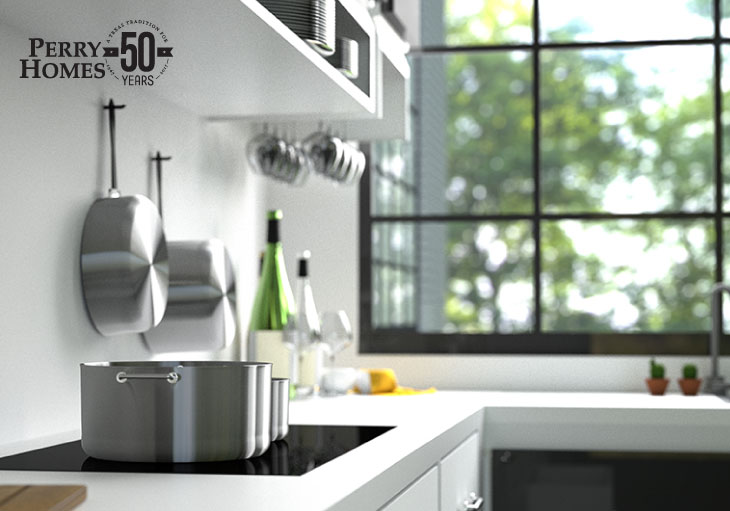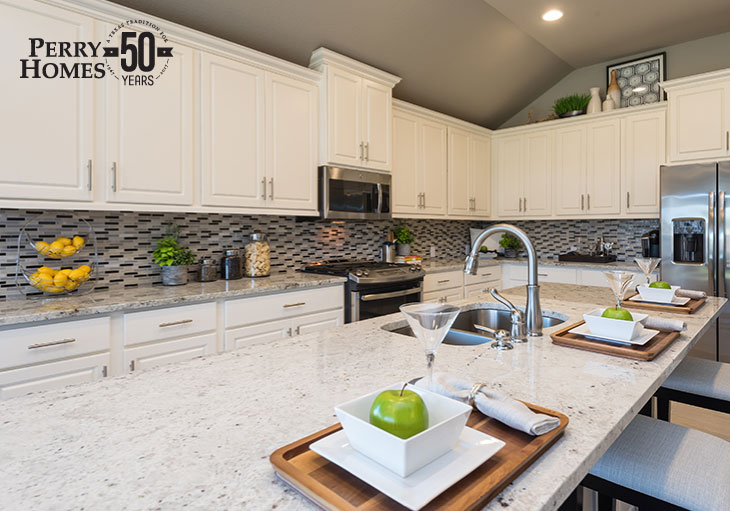
4 Simple Ways to Maximize a Small Kitchen
Follow these tips to get the most out of your kitchen design
A small kitchen is never ideal. Whether or not you consider yourself a home chef, you want your kitchen to be a welcoming, open space to share with friends and family. With a few creative small kitchen design tips and ideas, it is possible to emphasize and enliven the space you do have and make the most of it. No matter the actual size of your kitchen, you can create an open, inviting feeling in your home kitchen without pricy and irritating remodeling.
Eliminate clutter—and not just on your countertops
It can be expected that a room bursting at the seams with junk is going to feel small. So the first and best way to make a small kitchen seem larger is to eliminate clutter. This includes, of course, going minimal with appliances, stands and decorations on your countertops. Store appliances in cabinets and opt for a wall mounted or built-in spice rack.
A small plant or flower arrangement can go a long way towards adding some beauty and style to your kitchen without taking up a bunch of space. Windowsills and the tops of cabinets should remain clutter-free, as well. The picture above is a perfect example of this small kitchen design in action—the plants bring color and light to the otherwise sparse countertops.
You can also eliminate design clutter by ditching your cabinet fixtures. Functionally, your space will feel larger because you will be able to move in it more freely without snagging clothing or bumping into these unnecessary features. From an aesthetic standpoint, removing cabinet hardware actually creates a sleek, modern feel to your kitchen design. And if you need some help opening cabinets without hardware, look into push to open hinges and latches that can turn your small kitchen into automation heaven.

Create depth with cabinet upgrades
Cabinets can be one of the bulkiest elements in a small kitchen. They cut off the depth of the room and take up a lot of space. But they are also a functional necessity—especially if you are going to store away countertop appliances. If you are looking to give the illusion of space—and, more specifically, depth—to a small kitchen, you will need to minimize the effect of large, clunky cabinetry.
One of the easiest ways to create the illusion of space in a small kitchen is by removing the doors from your upper cabinets. This extends the depth of the room because it pulls the eye past the frames of the cabinet doors and through to the back wall. This same trick is achieved by adding glass cabinet doors. Just remember to keep your dishes stacked neatly on your shelves—they are now part of your kitchen’s interior design.
You can upgrade your cabinetry the easy way by purchasing new glass doors and installing them yourself—this option comes with a cost, of course. Or, if you are handy with a circular saw, you can install glass panels to your existing cabinetry if they are constructed by a frame surrounding a panel, like the ones above.
Either way you choose, you should consult a professional and your homeowner’s guide before attempting any installations.
Installing Glass Cabinet Doors
- You should first remove the doors and hardware from your cabinets, placing hardware in separate, labeled bags and numbering doors and cabinets to make for easier reconstruction.
- Next, find the tongue-and-groove joint on the top edge of the door. Measure the width and depth of the groove of each door on the cabinet.
- On the back of the cabinet, mark all four sides of the door in from the inside of the frame the depth of the groove. You should end up with a pencil frame slightly larger than the size of the cabinet’s current panel.
- Adjust the cutting depth of your circular saw to the depth taken previously. Cut out the panel following the markings you made. Do not forget proper safety precautions!
- Cut corners free using a wood chisel and remove the panel.
- Mark the dimensions of the insert on your glass and score it to the proper specifications.
- If you would like to paint your cabinet doors, do so now.
- Apply silicon to the interior of the frame and fit your glass panel inside. Press firmly on it and wipe off any excess.
- Allow the silicon to dry, then rehang your new glass face cabinet doors using the hardware you saved and labeled previously.

Let in the light
Natural light is an easy way to instantly enlarge any small space. If you have a window in your small kitchen, welcome the light by avoiding heavy window treatments. If you do not have much natural light to work with, of course, there are other ways to brighten up your space. The dark shadows often cast by cabinetry can be eliminated by adding simple lights under, above or even in your cabinets. You can attach LED strip light fixtures to the underside of cabinets or even simple, inexpensive battery-operated tap lights.
To emphasize the room’s light and create depth to your small kitchen, add reflective or mirror surfaces to your design. Stainless steel appliances and even a stainless steel or tainted glass backsplash are great examples. Ceramic tile and marble countertops also serve to reflect and bounce light throughout the room, and the reflective quality of these materials increase the room’s sightlines and add depth.

Stick to simple interior design elements
We talked earlier about clutter making a space feel smaller. The same concept applies to design clutter—bold colors, loud and large patterns take up a lot of visual space. So when it comes to designing a small kitchen, it pays to keep your color scheme and patterns simple.
You can never go wrong with a clean, white kitchen, for example. White gives the illusion of an open, seamless space, and it actually has that reflective quality we mentioned above that emphasizes natural light. Using contrasting textures and slightly different shades of white can help you avoid a clinical, sterile feel in your design.
You can also create that seamless look in your design by sticking to a low contrast color scheme in your small kitchen design. Choose colors that are similar to one another and blend well together. Avoid abrasive changes in color that draw attention to the limits of your space and fragment it. The image above is a perfect example of a kitchen with a low-contrast color scheme. The white cabinets, off white tile and light grey countertops blend nicely together as one large, cohesive space.
Patterns—whether in floor tiling, backsplashes or a large rug—should be simple and sparse. If you do want to bring a little flair into your small kitchen, stick with patterns like large chevrons, diamonds and horizontal stripes. These patterns are simple and even expand a space as the eye follows them from one side of the room to the other. You can take on a simple DIY project by painting thick, horizontal stripes in low contrast colors on your existing laminate or wooden floor.
Did this blog help turn your small kitchen into your favorite room in the house? Share the love and pass it on to your friends!
